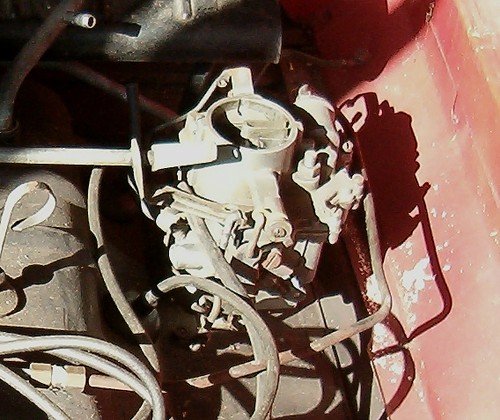
First, I got in touch with the prospective buyer of Lucy, and he said his wife wouldn’t let him buy an old car. So Lucy's in my competent (wink, wink) care for the foreseeable future. This whole little experience does give me pause. Maybe I should sell her and move on to something else – a different Corvair of course.
When I got home from work Tuesday, I went back to work on Lucy’s vacuum leak. The whole drive home I was hearing a whistling noise from behind me, and since I was carrying no musical passengers it must’ve been the engine. After removing the air cleaners, I stuck my fingers around the base of the right carburetor and could affect the sound. I removed that carb and the plastic insulator that fits between it and the base on the head. I closely inspected the insulator and found it had a crack through in the area where I felt the leak was at. After fishing a GUP insulator out of my box of carburetor GUPs, I reassembled the carb and attempted to start up the car. The car had sat about an hour at this point and that’s when the starter had failed before. At that point dinner was nearing so I acted like everything would be fine enough for me to balance the carbs the next opportunity I had and took all the tools back to the garage except for the clear hose and a screwdriver. I hope my optimism isn’t dashed.
Last night, since the wet weather was not conducive to carburetor adjustment, I spent a couple hours working at my carburetor collection. I wanted to find the two carburetors with the best-fitting throttle shafts. I found a couple that seemed promising, but were in the midst of disassembly with butterfly screws broken off, so I drilled those out and completed their disassembly. Then, one of the carbs I’d swap on to Lucy when trying to get her engine to idle is one I’d pulled off Ringo a while back. When installed on Lucy, it showed signs of flooding – gas dripping into the venturi after shutting off the engine, so I investigated the needle and seat. When supposedly closed, they did not put up much resistance to my blowing, so I replaced them with a new set I’d recently received from the Corvair Ranch. Now it’s, “open it, air blows; close it, air stops.” That’s the way it’s supposed to be. I found a carb marked LM, that, while the shaft would barely turn since the assembly was quite grotty, seemed to have a nice, close fit. I disassembled it completely and put the metal pieces in the gallon carburetor cleaner can for an overnight soak. Tonight I’ll be back in the garage to remove and rinse off the soaking parts. This may be the best candidate for the next rebuild. I’m trying to get a good pair that I can install on Ringo when his engine’s ready.

No comments:
Post a Comment